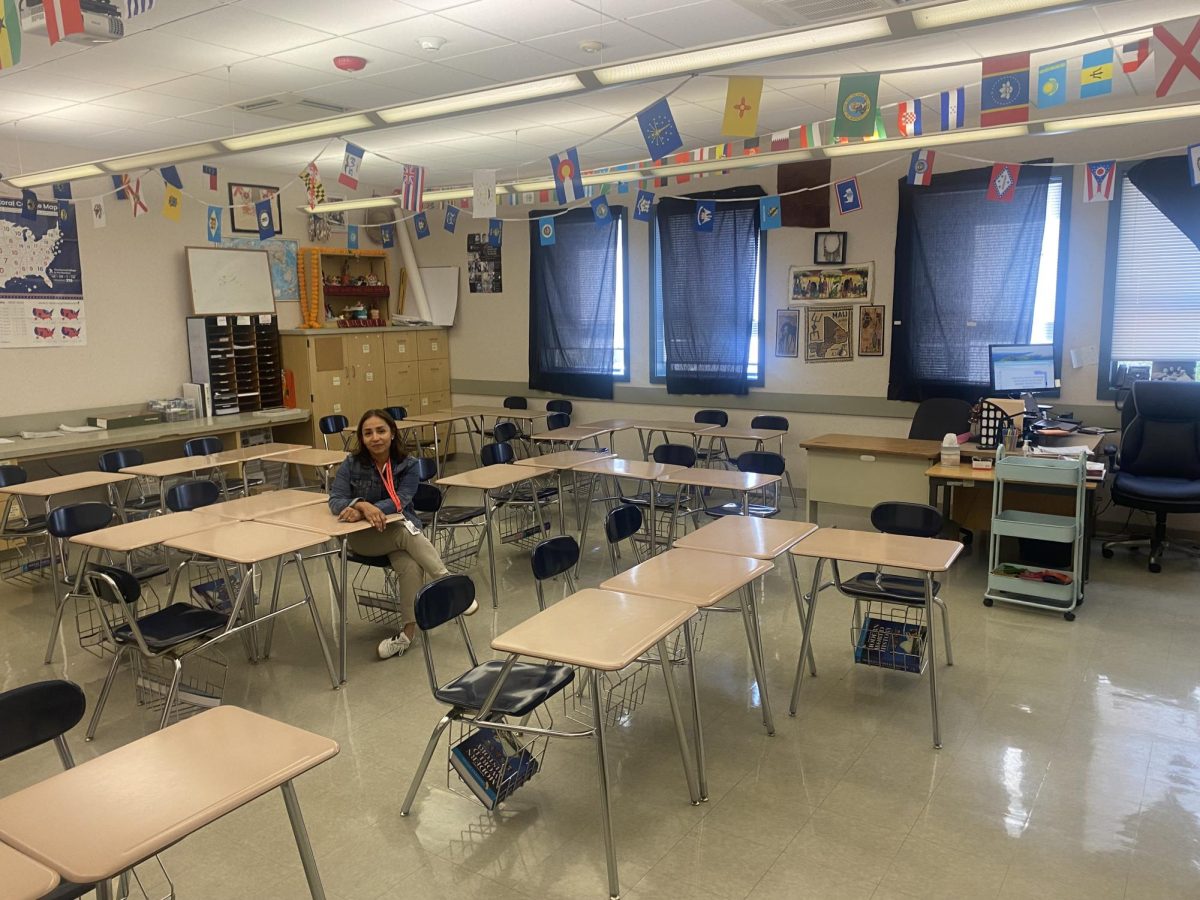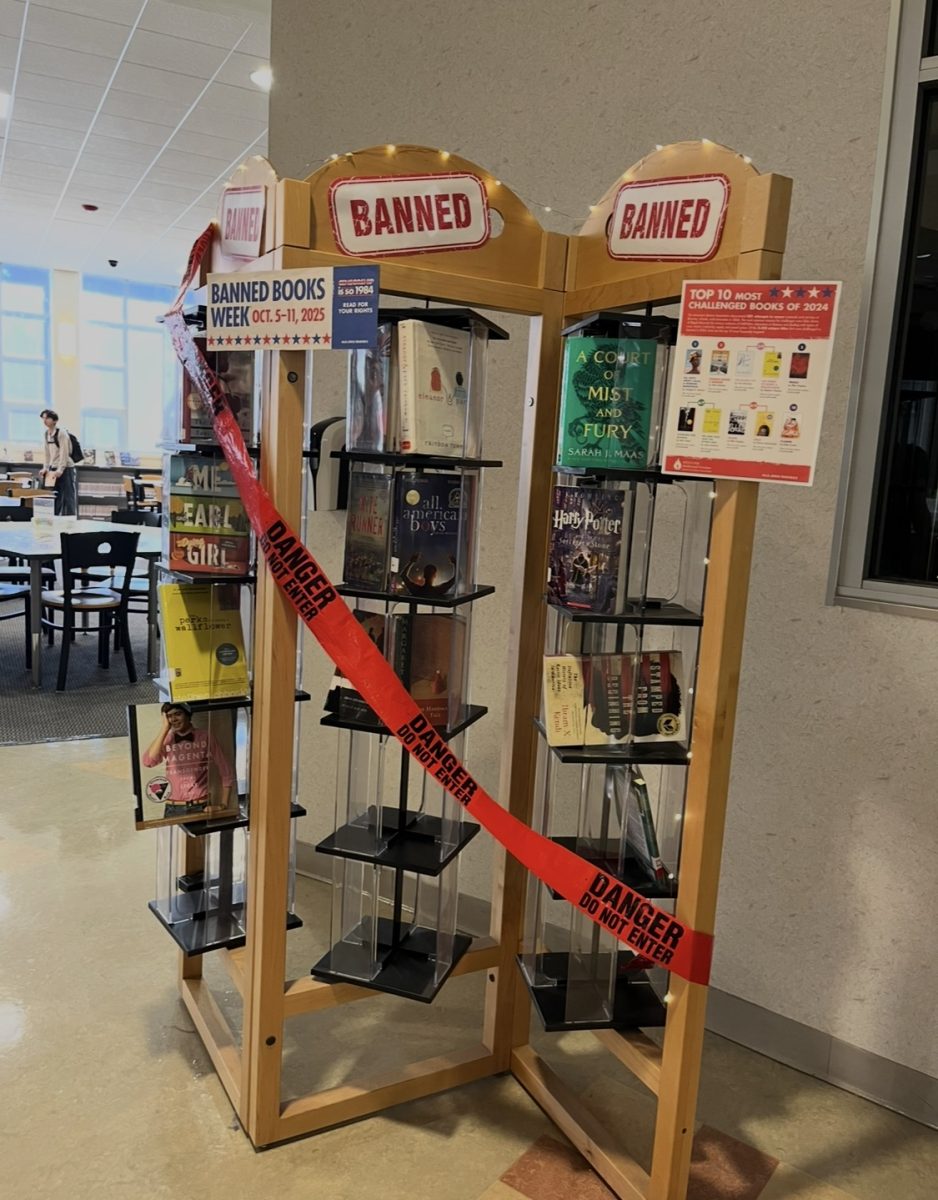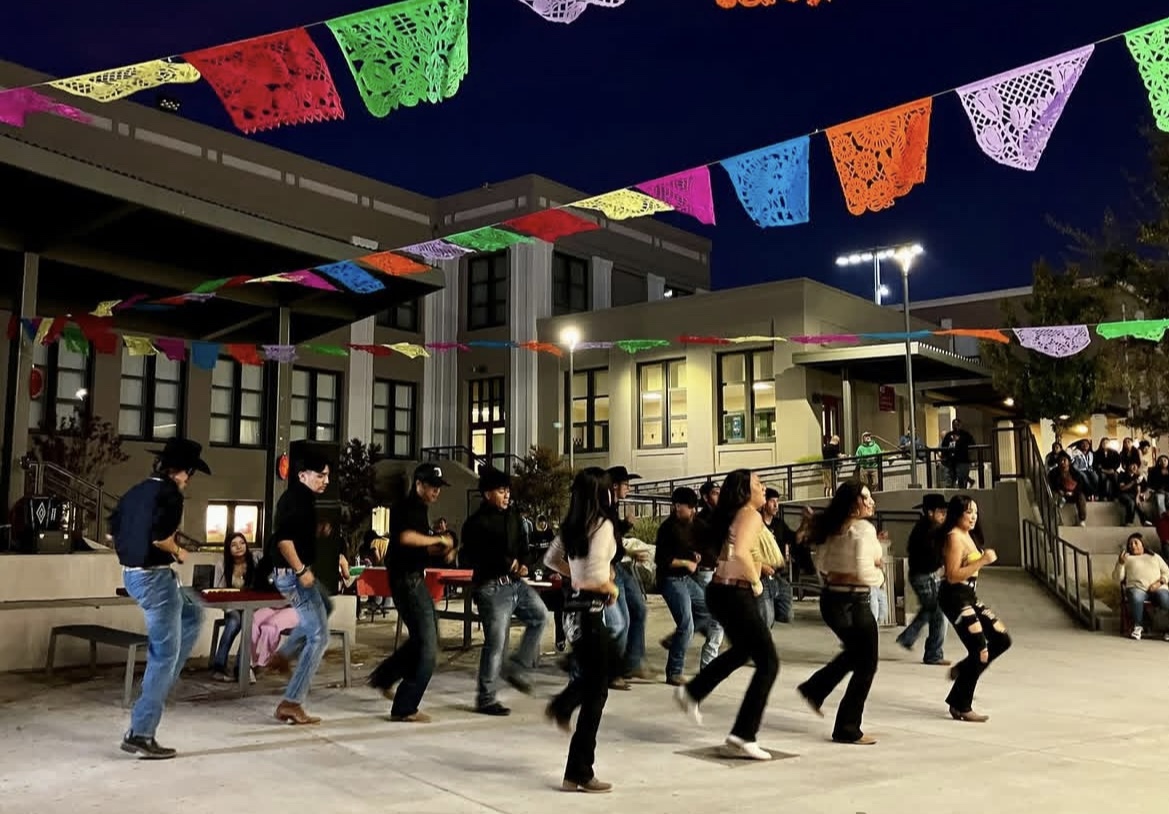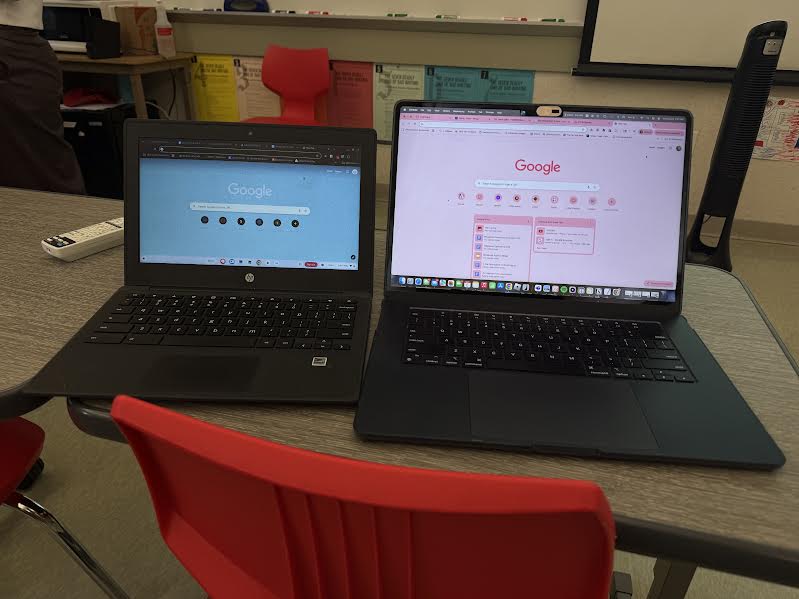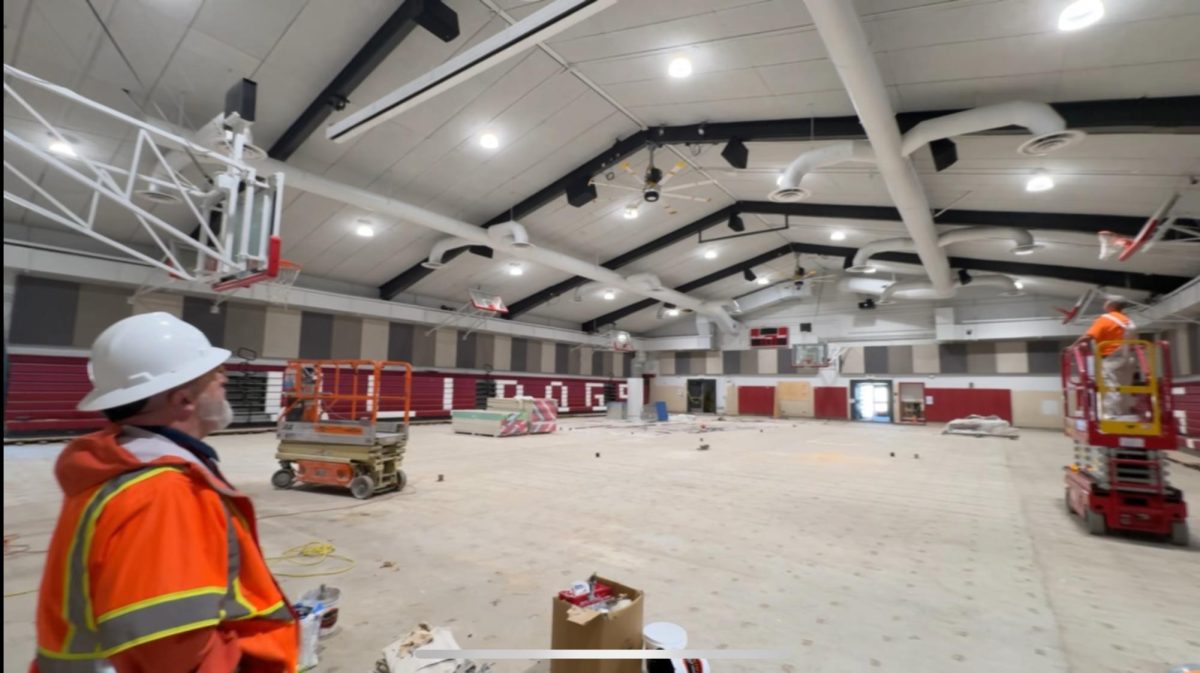Faded lights, a transparent map covering a large part of the window, colorful lanterns, and a list of all the students in the room are just a few of the things that make Amy Probst’s classroom at Coleman Elementary School feel like a home more than a classroom. On one wall hangs a poster with sentence starters for how to share how you feel. Each kid has a standing desk that allows them to stretch their legs while learning. These desks take up less space than a traditional desk and chair, so there is room for a huge rug at the back. Kids don’t just walk across the vibrant rug, they leap over the different colored squares. Their art is hung up on the wall as if it were on a refrigerator, and some kids are even walking around without shoes on.
The comfortable feeling doesn’t detract from the ambiance of learning though. Most of the space on all of the walls is fully covered with multiplication charts, important teachings, a cursive alphabet, and other educational resources.
When I walked into this third-grade classroom, Mrs. Probst was walking around and helping her students as they worked on a poetry task. Then, a volunteer came up and led the class in a pronunciation activity. She had a deck of cards, each with a vowel or group of letters (“ie,” “ing,” or “ay” for example). Once she showed the top card, the whole class pronounced it simultaneously. They went through the whole deck, card after card, pronouncing the fundamental sounds of the English language. After that, Probst did an activity where she would say a word, then ask someone to spell it.
“Break it apart… I want to hear the sounds,” she would say.

One of the main roles of an elementary school teacher is to build the foundational skills of the young kids in their class. Teachers are relied upon to teach students skills that will set them up for their future years of school and life. John Flanagan, who taught elementary school at Sun Valley Elementary School for many years, and currently teaches at Davidson Middle School, talks about how if kids learn more and have a better foundation of learning in elementary school, they’re more prepared to succeed in middle school, where they will then prepare for high school or a career.
After their pronunciation practice, Mrs. Probst assigned them a task related to the reading they had done the other day. They had to answer the reading comprehension question, and show where they found their answers in the text. As a senior in high school, I still do this. Weekly, if not daily, I am assigned something to read and questions about it.
In addition, elementary school teachers ideally aren’t just giving kids an education on foundational school skills, but one of emotional and social skills too. According to “Understanding a Teacher’s Long-Term Impact,” published in Edutopia, “an increase in measures of students’ noncognitive skills increased their likelihood of graduating from high school by 1.47 percentage points.”
In elementary school, I learned about things like personal space, filling people’s emotional “buckets” and how to interact with people who are being rude. School is one of the main ways people learn how to handle conflicts with peers and develop their maturity. These skills are crucial to their success, just like the ability to read, write and add.
In “12 Reasons Why Teachers Play A Crucial Role In Society,” on Teachers of Tomorrow, the author writes that “teachers guide students on behavioral issues like reducing anger, hostility, and other extreme emotions. As a result, they assist the students in learning how to cope with challenging situations without being violent. Teachers contribute to developing a society that values peaceful coexistence and understanding by instilling these values.”
Sasha Sanchez, another third-grade teacher at Coleman, reiterates this by saying that teachers “get to see human growth not just academic growth.” They are influential in students maturing in academics and in personality.
When I went into Mrs. Probst’s classroom, I asked the kids what they liked about their favorite elementary school teachers. John (all names are pseudonyms) said that his favorite was “kind.” Ally told me how hers “taught us different kinds of math.” Timmy said that she was “patient.” Others talked about how they were funny and never yelled. They taught them how to read, write in cursive, and use Chromebooks.
Even high schoolers remember their favorite elementary teachers. When describing his favorite, SRHS junior Frank Faulkner said that “she was always friendly, willing to help, supportive, and positive.” They have a big effect on students, as they teach young kids lasting skills used in higher grades, and in life.
They do such an essential job, but they are not paid according to their level of importance. How come they are paid less than high school teachers when they teach the necessary skills for high school? We need to change how we pay elementary teachers and how we see education as a whole.
There is a huge difference between the salaries of elementary school teachers and high school teachers. The San Rafael City School (SRCS) District website shows that an elementary teacher starting in a teaching job with just a BA receives $60,516 per year. A high school teacher with these same attributes gets $69,110. Fast forward, and a high school teacher with 10 years of experience, a BA and 60 education units gets paid $114,197. With the same number of years of experience and education units, an elementary teacher gets paid $102,120. That’s a $12,077 difference. How is this possible?
Matt Winton is a teacher at San Rafael High School and his wife, Ramina Winton, is a first-grade teacher at Glenwood Elementary School. Matt Winton believes that “because of the history of elementary school teachers being traditionally more women, the pay scale was lower for elementary school teachers back then.”
Another reason why the high school district has had better funding than elementary schools is that the funding comes from different places. The San Rafael High School District is funded by property taxes of the community around the school. The elementary school is funded per student by the state of California.
It’s harder than people think to pay teachers more. “When you work in education, you sign up to a system that is not as simple as a business that hires employees and can give them extra money when your business starts to be really successful,” explains Kelly Whelan, who is the co-chair of the San Rafael Teachers’ Association (SRTA), as well as a fourth-grade teacher at Coleman. Despite this challenge, the SRTA was able to get a new contract.
In 2022 and 2023 there was a period of negotiations between the San Rafael City Schools and the San Rafael Teachers Association. One of the main things teachers were requesting was a raise.
The state funds elementary schools and gives a yearly COLA (Cost of Living Adjustment). Inflation is one of the variables that determines how much the COLA is. For the 22-23 school year, as a result of the increase in inflation, there was a very large COLA.
They calculated the COLA money, money coming in from other sources, and district savings, and saw that it was a good time to get better payment for the over-the-top effort teachers had put in over Covid, and for the work they input now.
The SRTA puts out a survey every year, and the one before the negotiations showed that getting a raise was the top priority for its members. This was in a time of high inflation rates, but because of changes related to Covid, their last raise had been in June 2021.
“Job #1 for us was to really make sure that our members were going to be fairly compensated for the work they were doing,” Whelan says.
Another reason they needed this raise was because teachers were moving to districts that paid more. If San Rafael paid teachers less than somewhere like Mill Valley, why would a teacher stay in San Rafael? It was important for the SRCS elementary teachers’ pay to be similar to the pay of other districts around, so that skilled teachers would stay in San Rafael.
The SRTA was able to propose a new contract, and after months and months of negotiations, the district agreed to it. They were able to get a 8% base salary increase that went back to July of 2022, a 3% base salary increase that went back to January of 2023, and a 4% base salary increase starting in July of 2023.
During the 22-23 school year, none of the Davidson Middle School science teachers had a prep period. They had too few science teachers to get all students into a science class while supplying teachers with prep time. In the 23-24 school year (after the negotiations), they were fully staffed, and each got a prep period.
This new contract is a great start, but I think elementary school teachers should be paid the same amount as high school teachers. This would take a lot of effort, time, and planning, but I think it is essential for elementary teachers to be valued on the same level as high school teachers. Their pay should reflect this.
Sanchez started off as a part-time poetry teacher. She got to be around students, and therefore, around teachers. She got to see what their community was like and really admired them. She then went back to school and became a teacher herself.
Other teachers get into teaching because they love helping kids or are interested in the brain functions of children. Some are altruistic and genuinely want to be in a career that allows them to give back. “I don’t think every profession develops a sense of purpose like teaching does,” reflects Christopher Simenstad, an English teacher at San Rafael High School.
Along with being “really fascinated with the way people learn,” Flanagan believes that, “teaching people to read is a fundamental step toward social justice.” He’s able to help people understand what’s around them, and if something is true or BS. He helps students develop a “BS meter.”
Teachers help in the challenging development of elementary schoolers, but it comes with certain challenges as well. Sasha Sanchez is a third-grade teacher at Coleman Elementary School. Her class is the grade that missed in-person kindergarten. She is seeing the effects of a school year online – her class has had behavior issues this year.
Even in middle school, Flanagan sees that there’s a shorter average attention span among his students. He finds himself going over the top in order to captivate them enough to have them listen.
I am the daughter of two SRCS teachers; My mom is a teacher at Coleman, and my dad is a teacher at Davidson. I get to see the life of a teacher outside of the classroom. They spend their personal time working for their classes or planning activities. They do this even though teaching takes so much energy and hours of their day.
It’s also hard for them to be able to give attention to 24 different people at once. “We’re just ‘on’ all the time” is how Sanchez describes it. “Time is divided by each kid.” This leaves many teachers extremely tired by the end of a school day.
Even in the hours they’re not at school, it’s hard to disconnect. Teachers can be empathetic and caring, as their job is one of service, and this causes them to sometimes take on the pain they see in their students. “Educators by and large are incredible, passionate people…You carry a lot with you throughout the day and the weekend and the weeks and the years,” says Whelan. They know that kids experience brutal things outside of class when it’s out of their control, and this can be hard for teachers to deal with.
In addition, there are things added to the equation that they have to adjust to. There are curriculums that they are given, and Alyssa Jones, a teacher at Glenwood Elementary School for the last 11 years, says that it takes her 2 to 3 years to fully adjust to one.
In Probsts’ class, she released about ⅔ of the class to do individual writing and reading work. She took a small group to the rug and worked with them in a more individual way.
One way that many teachers differentiate is through doing reading groups; Kids are put in groups based on their skill in reading, and are assigned a book that fits this level. This differentiation fosters individual growth, rather than uniformity.
To be an exceptional teacher requires differentiation. Students are all individuals, so are each at a different level. By differentiating, teachers find a student’s current level, and help them. It requires specialized activities and a knowledge of where each individual is at.
This is especially hard in San Rafael because there is a wide range of students in regard to their literacy. Many students’ parents went to college, and read to their kids while they were growing up. This exposure helps kids succeed in school. Many others have not gotten this exposure because their parents are illiterate. It requires a teacher to put in lots of extra work to make differentiated plans when all these students from different families are in the same class.
An additional struggle that teachers face in regard to differentiation is that this must be balanced with government expectations. The state has grade level standards, and requires exams to be taken that evaluate if students are at their target skill level.
“Public education is such a machine… it can be hard to operate within a machine and a system that isn’t necessarily built for the students that you serve,” says Whelan. To be the best teachers possible, they work to differentiate, but they still need to give these one-size-fits-all exams. According to Whelan, they are the “absolute antithesis of differentiation.” In the future, she wants to see a system that, along with grade level requirements, values the progress students make. The hope is to have one that puts the same emphasis on growth and proficiency.
These tests are also incomplete because they don’t show the emotional growth of students. Teachers work so hard to grow their students’ maturity and emotional awareness, but there isn’t a standardized test for this. The article, ”Understanding a Teacher’s Long-Term Impact” from Edutopia says that “students’ long-term success is often less about academics than behavior.”
All this differentiation takes lots of planning. In their contract, SRCS elementary teachers get about 45 minutes of planning time every week. This is more than it used to be in years past, but still is not enough time to get done all of their tasks.
Because of this minimal amount of contracted prep time, almost every teacher I talked to puts in lots of extra time to their job. Casey Hodel works about an extra 2-3 hours a day, opening up her classroom as a study hall before school starts. Almost all of the school teachers I talked to get to their classrooms earlier than required, or stay later. Sometimes they do work on breaks or weekends. Furthermore, during conference season, they spend hours of their personal time preparing them.
Difference in prep time is a big difference between being a teacher at an elementary school and high school. The contracted prep time per week for elementary teachers is 50 minutes. High school teachers normally have 1 or 2 prep periods per day, each lasting either fifty or ninety minutes.
According to “Elementary Teaching vs. Secondary Teaching: Which Is Right for You?” in School of Education by American University, “Not surprisingly, the difference in maturity between a classroom of 6-year-olds and a classroom of 16-year-olds is drastic. Understandably, elementary teachers may need to devote more energy to classroom management compared to high school math teachers.”
There are many other differences between teachers of these different grade levels, but these don’t justify a change in pay. Some of the differences are harder for elementary school teachers. They need to be paid according to their value and clearly this value is no less than people who teach high schoolers.
This would be an amazing improvement, yet Whelan believes that our country has a bigger issue than teacher salary.
“Across the board, as a country, we have undervalued and underfunded public education for decades and we are seeing the effect of that now,” she says. Whelan thinks that our society needs a shift in their thinking. Are we valuing education? Are we valuing teaching as a profession? She says “our whole education system is in need of a revamp.” In this ideal educational system, there would be many things that would need to change
Along with an increased salary, there would be a suitable amount of resources for teachers to differentiate. There would be more psychologists, speech therapists, resource specialists available at the school.
If this whole system was redone, it could even have two teachers per classroom, or at least a teacher and an aid. This seems excessive, but it would benefit students.
“It’s really the work of 2 people,” says Simenstad, who seems to always have essays to grade.
If this is what it feels like for a high school teacher, the same should be true for an elementary school teacher who has a fraction of the prep time. This year Whelan has had a resident student teacher. This person is able to help her with the tasks and teaching she needs to do. There’s been big growth in Whelan’s class because of it. This shows that students could get more education from the same amount of time if there are 2 teachers per classroom.
Also, in this ideal education scene, there would be no segregation. In San Rafael there are still elementary schools that are mostly made up of Latino kids, and others that are made up of mostly white kids. How can kids learn to treat everyone equally if they experience this separation from such a young age?
These ideal education system components could take lots of time to set up, but the way it would affect kids, and society as a whole, would be so worth it. These changes would ideally be put in place by those who know students – teachers themselves.
They have such a strong impact on students, and therefore, on society. Elementary school is where kids are taught how to function in society and where they build opinions and perspectives. To give them the ability to thrive, it’s important to provide them with an incredible education in elementary school. This comes from amazing teachers. To have these committed, and influential educators, they need to be paid more, and given the resources necessary for educating kids.
“They should be paid based upon what they’re giving to society,” says Alex Peck, the principal of Coleman Elementary School.
I think that our society will be able to increase the value we put on education. Quality education provides society with people that are educated and emotionally mature, and we need to continue sustaining this through valuing education. This is achievable and can help us form a more developed society.

